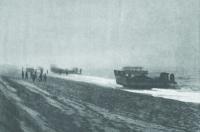
Americans landing in Algeria.
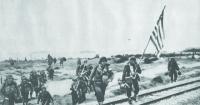
Americans landing in Morroco
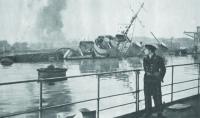
The French fleet
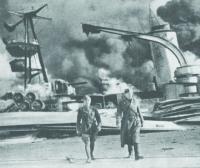
Destruction of the French fleet.
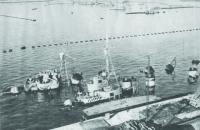
Destruction of the French fleet.
This week, 70 years ago, 1,400 Allied ships transported 107,000, mostly American, soldiers to attack the French colonies of Morocco and Algeria, in North Africa. The operation, named Torch, under the command of Gen. Dwight D. Eisenhower was divided into three (3) task forces - the Western, the Center and Eastern.
Western Task Force was commanded by Maj. Gen. George S. Patton, Jr. and consisted of the U.S. 2nd Armored and 3rd and 9th Infantry Divisions, commanded by Ernest M. Harmon, Jonathan W. Anderson and Manton S. Eddie.
The Center Task Force, commanded by Lloyd Fredendall, included the 1st Armored Division and the 1st Infantry Division ("The Big Red One"), commanded by Orlando Ward and Terry de la Mesa Allen, Sr. The 1st Infantry Division’s Deputy Commander was Theodore Roosevelt, Jr. - son of former President Theodore Roosevelt and cousin of President Franklin Delano Roosevelt. It was called the "Terry and Teddy Show."
The Eastern Task Force, commanded by General Charles W. Ryder, consisted of two brigades of the British 78th Division, under the command of Byvyan Evelegh and the U.S. 34th Infantry Division, commanded by Charles W. Rider. Although the Eastern Task Force was ostensibly under the command of British Lt. Gen. Kenneth Anderson, the landing force was commanded by American Gen. Ryder. Some of the British soldiers actually wore American uniforms in an effort to make all this more palatable to the French, who hated the British even more than they hated the Germans.
Aerial operations were split in two with the Western half being commanded by American Medal of Honor winner, Gen. Jimmy Doolittle and the Eastern half being commanded by British Air Marshal Sir William Welsh. One of the American Units was the 332nd fighter group - the famed Tuskegee Airmen. It was their first combat deployment.
Stalin, whose armies were losing 10,000 men a day, had pushed hard for a "Second Front." North Africa was not what he had envisioned! He was thinking of landings in France. The Americans were eager to accommodate their Soviet ally, but the British knew that they would be bearing the brunt of any cross-channel invasion, since their American cousins weren’t yet ready for such an undertaking. The North African invasion was a compromise between the British and Americans. Churchill flew, with President Roosevelt’s Special Envoy, W. Averill Harriman, by plane, from Cairo to Tehran, on August 10, and then, two days later on to Moscow to try to assuage an always suspicious Stalin.
That evening they met with Stalin, at which time Churchill told him that there would be no cross-Channel invasion that year. After Stalin glumly digested the news, the P.M. then proceeded to brighten his spirits by telling him of the coming invasion of French North Africa.
What was being invaded was French territory. On June 22, 1941, the French government, led by World War I hero Marshal Philippe Pétain - who, on July 10, 1940 would be granted dictatorial power by the French Parliament - executed an armistice with the German Reich. A few days later, it also executed a similar document with the Kingdom of Italy. These documents took it out of the war, but allowed it to maintain a semblance of its sovereignty. The armistice was only designed to define relations until such time as Great Britain came to its senses, or was defeated, and full-fledged peace treaties were executed by all. Neither France nor Germany thought that this would be long in coming. In the meantime, Axis forces occupied 3/5 of France, along the Channel and Atlantic coastal regions plus Paris. Just as importantly, more than 1,600,000 Frenchmen remained in German POW camps. On the other hand, the French Navy was still, relatively, intact. At the outset of the war, it had been the fourth largest in the world, and the Germans did not want it to align with the Allies, and would have liked to have used it themselves.
Against this backdrop, the Allies had to determine the reception of the French to this invasion of their territory. Would they fight? Many Frenchmen had the good sense to realize that the Allies, even Great Britain, were on their side, and if France was ever to reclaim its independence, its best interest lie in cooperating with the Allies. However, there were other Frenchmen who had been beguiled by the military successes of the Axis, German anti-Semitic and anticommunist policies and that hated the British. Added to that were the historic French prickliness and pride.
In an effort to show the French on which side their bread should be buttered, the Allies attempted to recruit General Henri Honoré Giraud. During the brief Battle of France, he had been commander of the French 7th Army and had been captured on May 19, 1940. He was held in Königstein Castle near Dresden, until April 17, 1942, when he escaped and made his way to Unoccupied (Vichy) France. In a meeting with General Eisenhower at Gibralter, he was offered command of all French troops. In response, he demanded command of the entire invasion force. At first, General Eisenhower thought there had been a mistake in the translation. When the translation was clarified, Ike was incredulous and dismissed General Giraud. On November 8, after the invasion was fully underway, General Giraud reappeared, much less pompous and arrogant and accepted Ike’s original offer.
In the meantime, President Roosevelt had sent Robert Daniel Murphy to French North Africa as his personal representative with the rank of Minister to French North Africa. Murphy, thinking that General Giraud was on board, represented that fact to the French officials in North Africa, the most important of which was General Alphonse Pierre Juin, who, in the Battle of France, had commanded the 15th Motorized Infantry Division. The French Government had sent him to Algeria to command the French forces there, with his headquarters in Algiers.
General Charles de Gaulle’s response to the news of the invasion is instructive - "I hope the Vichy people will fling them into the sea! You don’t get France by burglary." And this from an ally!
As the invasion was unfolding, Murphy drove to General Juin’s residence, and with some of his men, surrounded the General’s house and attempted to persuade him to side with the Allies. General Juin, however, deferred to his superior. It so happened that Admiral of the Fleet, Jean François Darlan, was in Algiers visiting his son, Alain, who had been stricken with polio. Admiral Darlan was also Minister of the Navy and Commander of the French Armed Forces. Eventually Admiral Darlan, after being promised leadership of France and receiving an invitation from President Roosevelt to send Alain to the United States for treatment of polio, ordered all resistence to cease, on November 10, 1942. Oran fell the same day. Casablanca was occupied and an armistice executed the next day.
The promise to Darlan enraged Gen. Charles DeGaulle and Prime Minister Churchill, who both considered the Admiral a collaborationist. This issue was resolved on December 24, 1942, when the Admiral was assassinated in his office by Fernand de La Chapelle, who was an employee of the British. The assassin was executed two days later by firing squad, eliminating the possibility of embarrassing questions.
In the meantime, the landings in Morocco were, initially, resisted by the French. Ultimately the landings were successful and Casablanca was captured - at a cost of 1800 American casualties. There were also three landings near Oran which were also resisted by the French. There was very little resistance to the landings near Algiers. General Juin surrendered the city at 6:00 p.m.
CONSEQUENCES
There were three immediate consequences of the Allied invasion of French North Africa. The first was the implementation of Case Anton. This was the name given to the planned occupation of the two-fifths of unoccupied France. This was accomplished by the German 1st and 7th Armies and the Italian 4th Army, and the Friuli and Cremona Divisions which occupied Corsica. By November 11th, the occupation was mostly complete.
A component of Case Anton was Operation Lila. This was the attempt by the Germans to capture what remained of the French fleet that had not been destroyed, by the British, at Mers-el-Kebir and Dakar or interned, by the British, at Alexandria. On November 12, Admiral Darlan urged the fleet to join the Allies. Following the occupation, German and French officials entered into negotiations regarding the French fleet based at Toulon, on the Mediterranean. On November 15th Admiral Darlan’s successor as Naval Minister, Admiral Gabriel Paul Auphan, attempted to convince Vice-Admiral Jean de Laborde, Chief of the High Seas Fleet at Toulon, to sail the fleet to the Allies. However, Admiral de Laborde had wanted to attack the Allies in retaliation for the invasion of French North Africa! Failing to convince Admiral de Laborde, Admiral Auphan resigned his position on November 18, 1942. As the 7th Panzerdivision (Rommel’s old division), commanded by Baron Hans von Funck, closed in, together with a motorcycle battalion from the SS Das Reich Panzerdivision, at 4:00 a.m. on November 27, 1942, Admiral de Laborde gave the order to scuttle. The French were able to delay the Germans, just enough, to successfully scuttle the fleet. Battleships Strasbourg, Dunkerque and Provence, four heavy cruisers, three light cruisers, 16 destroyers, 13 torpedo boats, 15 submarines and various other smaller warships were sunk. Two submarines reached Algiers and one reached Oran. A fourth made it to Barcelona. The trump card of Vichy France had been destroyed. It now had no leverage with the Axis. And the Germans still held more than a million French POWs.
The third immediate consequence of the Allied landings in French North Africa, was the Axis occupation of the French colony of Tunisia - after getting permission from the French government. This was something Mussolini had been advocating for more than a year; since the sea route from Italy to North Africa was shortest to Tunisia, making the task of the Regia Marina so much easier, and the risks so much smaller. Reinforcements and supplies, for which Field Marshal Rommel had been begging for months, were rushed to Tunisia, in the form of Luftwaffe units, the feared 88 artillery piece and more tanks and soldiers, including a few of the new monster Tiger tanks. Had these reinforcements and supplies been provided to the German "Desert Fox," a few months earlier, he would have made good use of them. As it was, they would only last a few more months before they joined the Deutsch-Italienisch Panzerarmee in captivity.
NEXT: THE DESTRUCTION OF The german sixth Army
Mr. Wimbrow writes from Ocean City, Maryland, where he practices law representing those persons accused of criminal and traffic offenses, and those persons who have suffered a personal injury through no fault of their own. Mr. Wimbrow can be contacted at wimbrowlaw@beachin.net
«Go back to the previous page.




